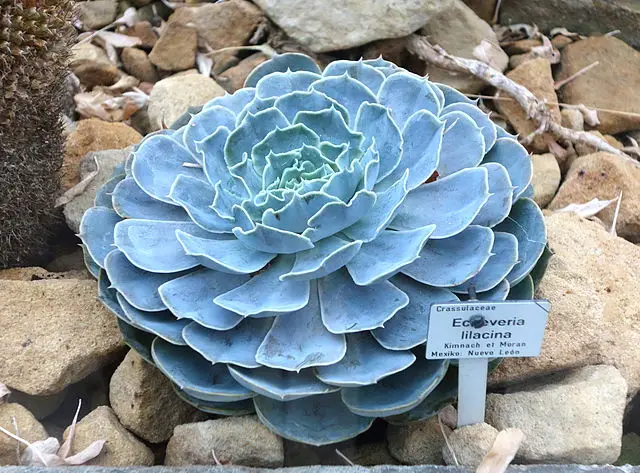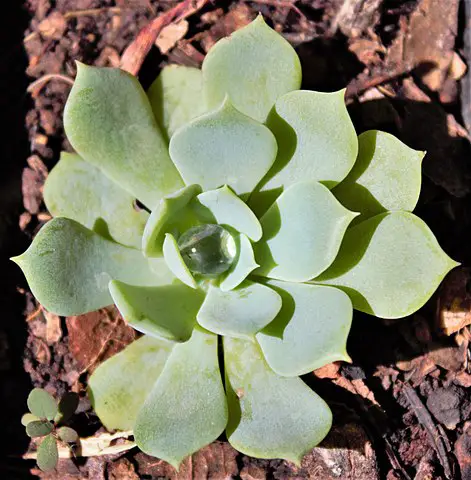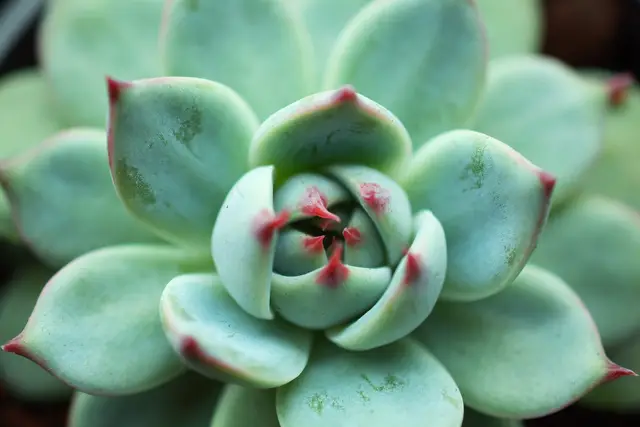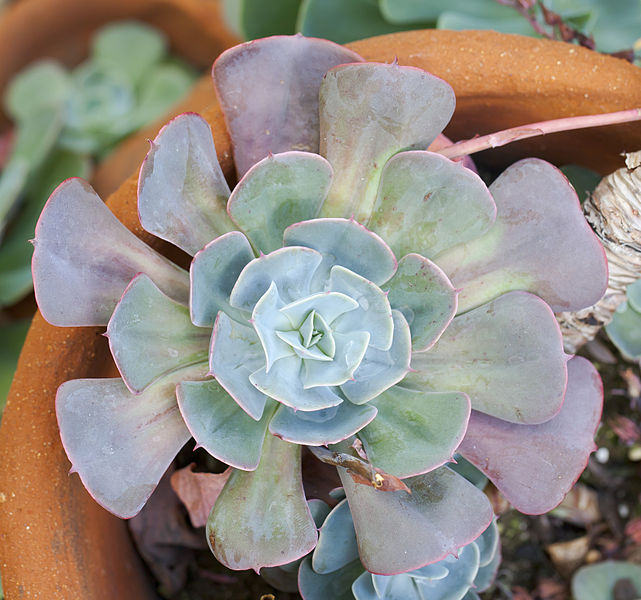Echeveria Lilacina, or the Mexican ghost echeveria, is proof that succulents do not always need to be big, bold, and brash for them to have value or be interesting. Ghost echeveria has unique qualities which make it stand out amongst echeverias for those who care to take note of them.
It’s dusky coloured leaves and gentle shape to its rosette means sometimes it blends into the background when compared to other plants, but it’s fascinating habits and the way it has adapted to its natural environment make it a plant which is worth getting to know for both beginner succulent growers or veteran plant fanatics.
Ghost echeveria was first described in the 1850s but became more popular in terms of propagation as houseplants took off in the latter half of the twentieth century. However, it was in the early 1800s that plant hunting was one of the major trends of the world and this led to the naming and transportation of many different kinds of echeveria as scientific expeditions went into the mountains of Mexico in search of new species.
Echeveria Lilacina, or Mecican ghost echeveria, can be distinguished from other echeverias by its pale colour, it’s winter flowering, and the gentle scalloped edges of its leaves. There aren’t many other echeverias it can be confused with because these specific characteristics put together are not found in any other echeveria. Therefore, by making note of these you can always be sure that you have a ghost echeveria.
When to Water Echeveria Lilacina?
Watering echeveria lilacina correctly is a matter of understanding both the weather conditions in its natural habitat as well as the type of soil it prefers, the way this drains, and how this affects it’s growth. Echeveria lilacina lives in semi desert areas of central America and as a result goes for long periods of time without water.
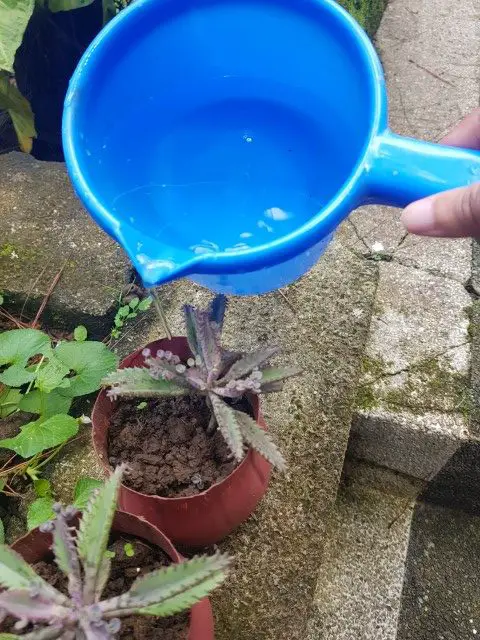
Therefore it has adapted to deep watering with breaks in between where the soil is allowed to fully dry up. Any more watering than this and it can actually develop root rot. Luckily there are ways to prevent this before it happens and to mend any damage if it does.
In fact, the plant’s natural habitat is semi-arid, rocky, mountainous regions, specifically the state of Nuevo Leon – therefore ghost plant appreciates being slightly pot bound and fast draining soil. The classic mixture of regular soil with sand or sand and perlite, or even using entirely specialist cactus soil, is perfect for ghost echeveria as it ensures the roots do not stand in water for too long. Water deeply, directing water at the soil only, and ensure you do not get any on the leaves as this can cause them to rot. Allow the plant to dry out entirely between waterings.
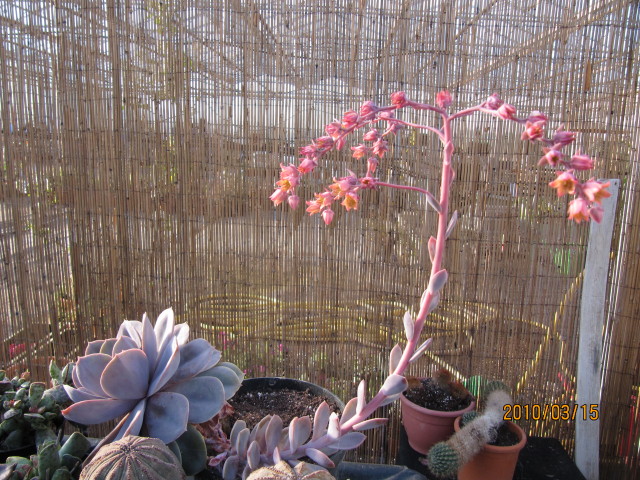
Mexican ghost echeveria stands out amongst succulents for its winter flowering season, during which it grows pinkish red flowers on a stem which is the same dusty grey colour as it’s leaves. It’s leaves are also significantly flatter than other echeverias, meaning it has a streamlines sophisticated look perfect for a modern home, garden, or office.
With much of the appeal of succulents coming from their perceived cuteness and photogenic abilities, it is refreshing to encounter a mature looking ghost echeveria with its striking combination of tones. Keeping a ghost echeveria around means that you will never be short of something happening with regards to your plants – no matter the weather or how cold and overcast it is, the Mexican ghost echeveria will be developing flowers so long as it is well looked after, healthy, and happy. Ghost echeveria is non-toxic and grows in US hardiness zones 9 to 11.
This winter flowering season means that all the more care must be taken with your ghost echeveria in order to ensure it gets the correct conditions over its flowering season, when it is using more and more energy and may be particularly susceptible to pest attack or the ravages of over or under watering. However, succulents often do not do well with fertilising and therefore there are no shortcuts to creating your ghost plant’s optimum growing conditions – care must be taken to ensure temperature, light, and positioning as well as watering are all in line with your plant’s natural tendencies.
As Nuevo Leon – where ghost echeveria grows – is northerly and it makes it’s home in mountainous regions full of cliffs and crags, it’s roots anchor to what may look like bare rock but is actually part of a complex ecosystem where ghost plant makes up part of a food web by which the whole natural world is connected.
If you live in the correct climate, your ghost plant can even attract hummingbirds, as these are the plant’s natural pollinators in the wild. It’s winter flowers mean that a source of nectar is available at times when other food sources are lean, and with their pink stems they are a welcome sight against the grey of the plant’s leaves.
Overall, it’s growing conditions involve deep watering interspersed with allowing the soil to dry out completely, and temperatures of 20-27 degrees Celsius during the day and 10-21 degrees Celsius at night to create the temperature drop between night and day which exists in its natural habitat. If you do decide to keep your echeveria Lilacina outside, bring it in before the temperature drops to five degrees Celsius if you live in a frost prone area as ghost echeveria is not exposed to frost in its natural habitat and therefore cannot tolerate it. Otherwise, read on to find out about more specialist issues for your ghost echeveria, including common pests and diseases and what to do about them.
Pests and diseases
Ghost echeveria is similar to many other kinds of echeveria in the types of pests and diseases it gets. It can be susceptible to the attacks of insects such as mealybugs and aphids, which suck the juices from inside the tender young stems of your plants, making them wither. Instead of treating these insects with commercial insecticide, try neem oil, which is a natural essential oil which comes from a tree grown in parts of India. This oil kills the pests without damaging the delicate leaves of your ghost plant.
One disease of ghost echeveria and all succulent plants is black mould. This shows up as black patches on the leaves and stem and ultimately although it is considered less harmful than some other pests and diseases, in the end it isn’t advisable to leave it there because it can weaken your plant and make it much more susceptible to damage from other pests or to the effects of over or underwatering. It also makes your plant less able to tolerate the heat and cold, which can lead to sunburn on the leaves or to stunted growth from not getting enough energy. It is good practice to remove any shrivelled leaves from around the base of the plant on a regular basis – they can otherwise become a breeding ground for mites, scale bugs, and black mould. Apart from this though, very little regular pruning is need of ghost echeveria.
Why is Echeveria Lilacina growing too long?
A common problem for all succulents is etiolation, which is when the plant begins looking leggy as a result of not getting enough light. Therefore as it tries to grow towards what little resources are available, it stretches itself. This is something to take note of for ghost plant especially due to the fact that in the season with low light – winter to early spring – it is actually using more energy than normal due to flowering. If your plant is etiolated, the best way to solve this is to chop the top of with a pair of clean secateurs which have been sterilised in hot water, and replant this so it grows new roots. Dipping it in a little rooting powder can be helpful. The rest of the plant can then be leaf propagated or stem propagated.
Echeveria Lilacina Repotting
It is generally not advised to repot ghost echeveria frequently as the plant does not grow offsets prolifically. Instead, it expands outwards slowly, simply becoming a much broader and more mature version of itself. Occasionally in mature plants it does form offsets around the base of the plant and these are much smaller compared to the plant itself. Nevertheless, it is not generally an offset forming plant like echeveria peacockii – and it’s charm comes from its understated tones and winter flowering.
As it does not form offsets as readily as other echeverias, ghost echeveria must be propagated by leaf or by stem. Like all echeverias, it can be grown from seed, but this process is not advisable for beginners due to the delicacy of looking after seedlings, the specific conditions they require, and the difficulty in practically collecting the seeds, which are often so fine that they look like dust and can be confused with the soil the plant is growing in.
Echeveria Lilacina Propagation
Propagation by leaf is therefore the most advisable method of propagating ghost echeveria. Like with all succulents in the echeveria genus, pull leaves gently off the base of the stem by twisting them or wiggling them from side to side to ensure they break away cleanly from the rest of the plant. This ensures roots will grow properly and the leaf will not get infected.
For best results, take several leaves and lay them all flat on soil or a kitchen towel. Within a few days, they should have calloused over, but it will be two to three weeks before they begin to grow roots – and even then, it is only when a rosette has fully grown that they should be transferred to their own soil. Ghost echeveria is one of the more slow growing succulents and this should be kept in mind during the propagation process. It is also very important to keep your new plants dry until the larger leaf has shriveled entirely.
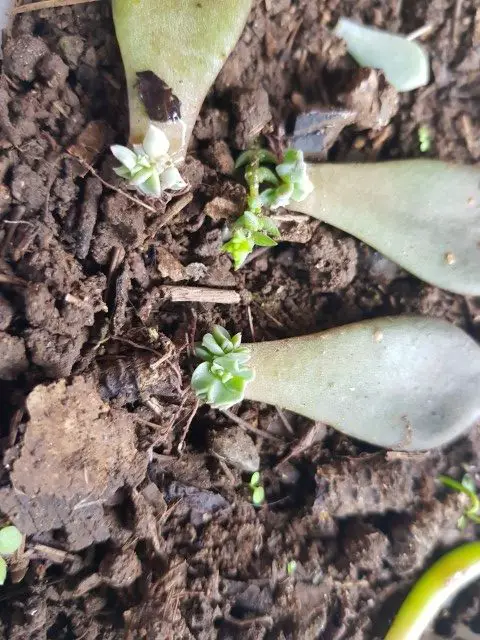
There are many additions you can buy to promote growth in your ghost echeveria. These include grow lamps and heated mats, both of which are intended to maximise the amount of light and heat for your ghost echeveria in order to create the conditions found in its natural habitat.
However, before buying these, first consider the placement of your plant, because with a well-chosen placement, it generally isn’t necessary to give your plants such intense focus with man-made products – an intuitive understanding of its processes which comes from learning about its natural environment and how it lives in the wild can actually go much further in terms of keeping it happy and healthy. Therefore, if your ghost echeveria develops problems, before rushing to buy products such as fertiliser it is best to carefully consider other factors such as whether the room you keep it in is warm enough or even whether a pest infestation is weakening it’s growth.
In conclusion, ghost echeveria is an unusual looking echeveria which is worth considering if you want a plant slightly different from the norm. It is a succulent which may not be immediately as eye catching as some of the perennial favourites such as echeveria elegans but if given time it will reveal its unique qualities to the careful grower who takes their time to get to know it’s requirements. If so, keeping a ghost echeveria can be an extremely gratifying pastime and help you get to know your other succulents better too.

